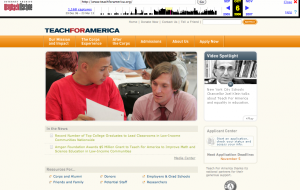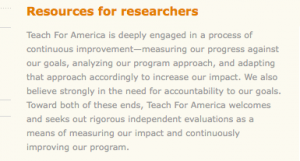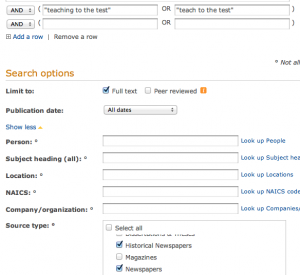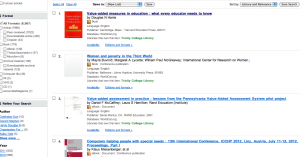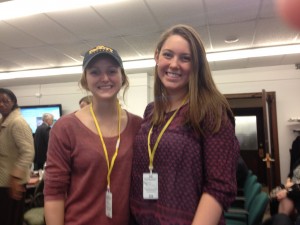Research Question:
According to Fred Hess, education reform and reformers have been applying the same reform styles to improve the education system, meaning that they have been doing the same thing over and over again. How do President Bush’s bill No Child Left Behind and President Obama’s program Race to the Top either confirm or challenge Fred Hess’s opinion?
Relevance:
Fred Hess is challenging the effectiveness of educational reformers and their reforms. By analyzing the actual legislation of No Child Left Behind and the program details of Race to the Top as well as the internal congressional discussions, it will be apparent whether or not he is accurate. If Fred Hess is right, then our government needs to seriously revamp their logic and reforms. However, if Fred Hess is wrong, it may be that the public is too critical of the government and their efforts to reform schools. The answer to this question is extremely relevant because it needs to be answered correctly in order to insure progress is being made for education reform.
Research Process:
Initially, I met with Katy Hart, the librarian, to help me find some sources. However, I did not have a focused enough question in order for that to be the most productive. As a result, I decided that I needed to meet with you. With your help, you gave me Patrick McQuinn’s book on No Child Left Behind, which help lead me to other secondary sources, another written by him as well. Furthermore, through the perspective of Fred Hess I felt it was appropriate to have full access to his book The Same Thing Over and Over. In order to receive some summary of what was happening in Congress in regards to these two pieces of legislation I researched New York Times articles and found plenty. Additionally, I searched through the Congressional Records database on the library website and found a sufficient amount of sources for No Child Left Behind. However, personally, I struggled to find congressional records in regards to Race to the Top. In order to solve this dilemma I met with Katy Hart again and she was extremely helpful. From there, I found more than enough dialogue and discussion within Congress in regards to No Child Left Behind and Race to the Top.
Bibliography:
Alvarez, Lizette. “House Votes for New Testing to Hold Schools Accountable.” New York Times, May 24, 2011.
Brown, Cynthia G., Hess, Frederick M., Lautzenheiser, Daniel K., and Owen, Isabel. “State Education Agencies as Agents of Change: What It Will Take for the States to Step Up on Education Reform.” Center for American Progress. July 2011.
This report “will provide the basis for a complete re-examination of the role of state education agencies and their chiefs in transforming the SEA into an agent of change that can assist districts in the crucial task of remaking our public schools to meet the needs of our children in the 21st century.”[1]
Dillon, Sam. “Dangling $4.3 Billion, Obama Pushes States to Shift on Education.” New York Times, August 17, 2009.
Hess, Frederick M. The Same Thing Over and Over: How School Reformers Get Stuck in Yesterday’s Ideas. Cambridge: Harvard University Press, 2010.
Hess, Frederick M., Petrilli, Michael J. and West, Martin R. “Taking Stock of a Decade of Reform: Pyrrhic Victories?” Education Next11 no. 2 (Spring 2011): 58-65.
House of Representatives, United States Congress. Challenges to American Competitiveness in Math and Science, Hearing Before the Subcommittee on 21st Century Competitiveness of the Committee on Education and the Workforce, Hundred Ninth Congress, First Session, May 19, 2005. 109th Cong. Washington: U.S. Government Printing Office, 2005.
House of Representatives, United States Congress. Implementation of No Child Left Behind Act, Hearing Before the Subcommittee on Education and the Workforce, One Hundred Seventh Congress, Second Session, July 24, 2002. 107th Cong. Washington: U.S. Government Printing Office, 2002.
House of Representatives, United States Congress. Strengthening America’s Competitiveness Through Common Academic Standards, Hearing Before the Committee on Education and Labor, One Hundred Eleventh Congress, First Session, April 29, 2009. 111th Cong. Washington: U.S. Government Printing Office, 2009.
House of Representatives, United States Congress. The Future of Learning: How Technology is Transforming Public Schools, Hearing Before the Committee on Education and Labor, One Hundred Eleventh Congress, First Session, June 16, 2009. 111th Cong. Washington: U.S. Government Printing Office, 2009.
House of Representatives, United States Congress. The Obama Administration’s Education Agenda, Hearing Before the Committee on Education and Labor, One Hundred Eleventh Congress, First Session, May 20, 2009. 111th Cong. Washington: U.S. Government Printing Office, 2009.
McGuinn, Patrick. No Child Left Behind and the Transformation of Federal Education Policy, 1965-2005.” St. Lawrence: University Press of Kansas, 2006.
McGuinn, Patrick. “Stimulating Reform: Race to the Top, Competitive Grants and the Obama Education Agenda.” Educational Policy (November 28, 2011), 136-159.
“This article offers an analysis of the origins, evolution, and impact of the Obama administration’s Race to the Top (RTTT) competitive grant program and places it in the broader context of the debate over the No Child Left Behind Act and the shifting intergovernmental relations around education.”[2]
Schemo, Diana Jean. “Bush Seems to Ease His Stance on the Accountability of Schools: Favors Senate Bill Over a Stricter House Version.” New York Times, July 10, 2001.
Tanner, Daniel. “Race to the top and leave the children behind.” Journal of Curriculum Studies 45, no. 1 (February 15, 2013): 4-15.
Tracks the education reform movement from President George H. W. Bush to President Obama and more specifically the charter school movement, “The modern movement for charter schools was advocated by President George H.W. Bush in America 2000, issued in 1991, and subsequently expanded in the No Child Left Behind Act of 2001, signed by President George W. Bush. The charter school movement, coupled with nationalized testing, was to gain great momentum under President Barack Obama in Race to the Top––raising a clear and present danger of splitting up the school system.”[3]
[1] Cynthia G. Brown, Frederick M. Hess, Daniel K. Lautzenheiser, and Isabel Owens, “State Education Agencies as Agents of Change: What it Will Take for the States to Step Up on Education Reform,” Center for American Progress, July 2011.
[2] Patrick McGuinn, “Stimulating Reform: Race to the Top, Competitive Grants and the Obama Education Agenda,” Educational Policy (November 28, 2011), 136.
[3] Daniel Tanner, “Race to the top and leave the children behind,” Journal of Curriculum Studies 45 no. 1 (February 15, 2013): 4.


